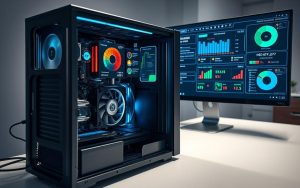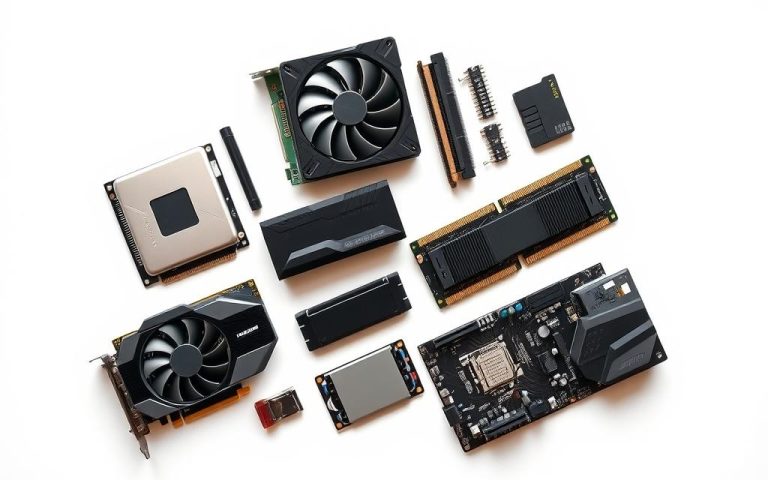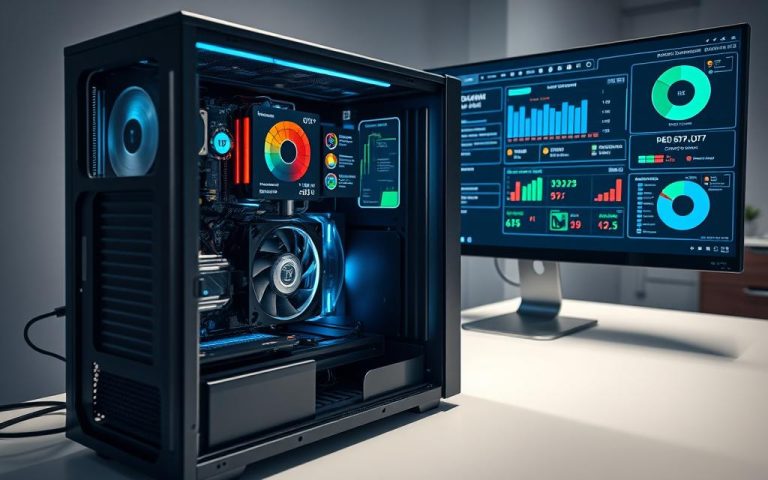What Is Computer Hardware? Definition & Key Examples
Computer hardware forms the physical backbone of digital technology. It includes tangible components vital for computing systems. These parts process, store, and transmit information across various tech platforms1.
Key hardware elements include the CPU, RAM, and motherboard. These components determine a computer’s processing power. Different devices need specific hardware setups to work well23.
Hardware evolution has been astounding, driving tech progress. The 21st century has seen huge leaps in computational power. These advances stem from improved processor design and increased parallelism3.
Computer hardware encompasses a wide range of components. These include internal processing units and external peripherals. All parts work together to turn digital instructions into computing experiences.
Hardware is the foundation of technological innovation. It brings digital concepts to life through physical components. Understanding hardware is crucial for grasping modern computing’s potential.
What is the definition of hardware on a computer?
Computer hardware consists of physical components that form the core of digital technology. These tangible elements are essential for computer systems to function effectively4. Most computers share three key hardware parts: CPU, RAM, and persistent storage4.
Understanding Hardware vs Software
Hardware and software have a symbiotic relationship. Hardware includes touchable components, while software provides intangible instructions. Hardware definition focuses on the physical nature of computer parts.
These machines, circuits, and mechanisms process, store, and execute digital tasks. They form the foundation of computing systems.
The Role of Hardware in Computing Systems
Physical components greatly influence a computer’s performance. The CPU handles multiple tasks at once, needing efficient cooling4. A computer’s processing power affects its ability to manage complex operations.
Higher gigahertz (GHz) ratings indicate faster performance5. This measurement helps users understand a computer’s capabilities.
- CPU speed measurement in GHz
- RAM capacity influencing computer performance
- Storage drive compatibility
Physical Components Overview
Modern computing systems use various hardware components. A typical setup includes several essential elements.
| Internal Components | External Components |
|---|---|
| Motherboard | Monitor |
| Power Supply Unit | Keyboard |
| Graphics Card | Mouse |
| RAM | Printer |
Upgrading RAM is one of the best ways to boost computer performance5. Modern systems often have 16GB of RAM, meeting growing multitasking needs6.
Hardware is the physical manifestation of computational potential, transforming abstract instructions into tangible actions.
Essential Internal Hardware Components
Internal hardware forms the core of computer systems. These vital parts work together to process, store, and manage digital information. The main components include the motherboard, CPU, RAM, and storage devices7.

Multicore processors are now crucial in modern computing. Most business computers have processors with two or more cores. These run at speeds of 2 GHz, handling most professional tasks well7.
- Motherboard: Central communication hub connecting all internal hardware
- CPU: Primary processing unit executing computational instructions
- RAM: Temporary memory storage for active applications
- Storage Devices: Long-term data preservation mechanisms
Random Access Memory (RAM) is key to system performance. Businesses usually need at least 4 GB RAM. For demanding tasks like design, 8 GB is recommended7.
RAM acts as a temporary memory bank. It greatly speeds up data retrieval times8.
| Internal Component | Primary Function | Performance Characteristic |
|---|---|---|
| CPU | Process computational instructions | Multiple cores, 2 GHz+ speeds |
| RAM | Temporary data storage | 4-8 GB recommended |
| Storage | Long-term data preservation | 500 GB minimum recommended |
Modern storage tech offers big improvements. Solid State Drives (SSDs) are a leap forward in technology. They’re 5-8 times faster than traditional hard disk drives7.
SSDs cost more per gigabyte. However, their speed and reliability make them appealing to many users8.
The heart of any computer system lies in its internal hardware, where each component plays a vital role in processing and managing digital information.
External Hardware Components and Peripherals
Computer peripherals enhance digital device functionality. These external components allow users to interact with computers through various input and output methods. Connecting different hardware components expands a computer’s capabilities.
Exploring Input Devices
Input devices are vital tools for user-computer communication. They enable users to input data and commands effectively.
- Keyboard: A primary input device with approximately 104 keys in a standard QWERTY layout9
- Mouse: With an average response time of 1-5 milliseconds9
- Microphone: Enabling voice input and digital communication
- Touchpad: Common in laptops for cursor navigation
Output Devices and Interactions
Output devices turn computer data into human-readable formats. Monitors are crucial, with plasma screens producing high resolutions up to 1920 x 10809.
The global computer peripherals market was worth about £40 billion in 20229. This shows the importance of these devices in modern computing.
Storage Peripherals
External storage devices are vital for managing digital data. USB flash drives last about 10 years9, while memory cards offer portable storage solutions.
The external storage market may reach £50 billion by 20269. This growth reflects the increasing need for additional storage options.
Over 60% of users now prefer wireless peripherals9. This trend shows a growing demand for convenient and flexible computer hardware.
Hardware Architecture and Performance
Computer architecture is vital for grasping system design and hardware performance. It’s a complex field that impacts overall system efficiency. Multiple design parameters need careful consideration.
Modern computer architecture uses several approaches to boost performance:
- Von Neumann Architecture: Features a single memory space for data and instructions10
- Harvard Architecture: Enables simultaneous access to instructions and data10
- Modified Harvard Architecture: Utilises separate caches for improved retrieval speeds10
Performance optimisation is crucial in today’s system design. Processors now use advanced techniques to enhance computational abilities.
These techniques include caching, pipelining, and parallel processing10.
| Architectural Approach | Key Performance Characteristics |
|---|---|
| RISC Processors | Simple instructions, faster clock speeds, lower power consumption10 |
| CISC Processors | Complex instructions, potentially reduced programming complexity10 |
New technologies are pushing the limits of traditional hardware architecture. Neuromorphic and quantum computing promise revolutionary computational capabilities10.
The future of computer architecture lies in balancing performance, energy efficiency, and computational complexity.
Types of Computer Hardware Systems
Computer hardware systems are diverse technological devices for various computing needs. Personal computers are the most versatile and accessible hardware systems. These range from compact PCs to sophisticated servers and specialised embedded systems.
The primary categories of hardware systems include:
- Personal Computers (Desktop and Laptop)
- Servers
- Embedded Systems
- Mobile Devices
- Mainframe Computers
- Supercomputers
Each hardware system serves unique purposes across different sectors. Personal computers have essential components like motherboard, CPU, RAM, and storage devices11. These systems offer flexibility and performance for everyday computing tasks.
Servers are powerful hardware systems for managing network resources and hosting websites. They have robust architecture and enhanced processing capabilities.
Embedded systems are specialised hardware in specific devices, from appliances to industrial machinery. These compact systems perform dedicated functions efficiently.
Modern hardware systems are evolving with advanced technologies. They include network hardware, improved storage solutions, and sophisticated cooling mechanisms.
Conclusion
Computer hardware drives digital innovation in our rapidly advancing technological world. Understanding its importance is crucial as computer hardware components reshape our digital interactions12. Modern computers can perform millions of calculations per second, showcasing remarkable computational power12.
Hardware architectures have evolved dramatically over time. Early mainframes were exorbitantly expensive to rent13. Today’s devices are compact yet powerful, reflecting unprecedented innovation in the field.
Future trends point towards further miniaturisation and improved performance. Emerging technologies like quantum computing promise to revolutionise computational capabilities5.
Hardware’s significance goes beyond technical specs. It represents humanity’s ability to innovate and push computational boundaries. As hardware advances, we can expect more efficient and versatile computing systems.
These advancements will unlock new potential across various sectors. From scientific research to creative industries, the impact will be far-reaching and transformative.
FAQ
What exactly is computer hardware?
How do hardware and software differ?
What are the primary internal hardware components?
What input devices can interact with computers?
How do hardware architectures impact system performance?
What different types of computer hardware systems exist?
What emerging trends are shaping computer hardware?
How do storage devices function in computer hardware?
What role does the CPU play in computer systems?
How do external peripherals enhance computer functionality?
Source Links
- https://www.techtarget.com/searchnetworking/definition/hardware
- https://uk.crucial.com/articles/pc-builders/what-is-computer-hardware
- https://en.wikipedia.org/wiki/Computer_hardware
- https://www.pdq.com/sysadmin-glossary/hardware/
- https://www.crucial.com/articles/pc-builders/what-is-computer-hardware
- https://www.itamg.com/it-asset/hardware/computer/
- https://www.nibusinessinfo.co.uk/content/computer-hardware-components-and-specifications
- https://medium.com/@aleriquene/the-basics-intro-to-computer-internal-hardware-components-772030cf245a
- https://www.tpointtech.com/hardware
- https://em360tech.com/tech-articles/what-computer-architecture-definition-types-structure
- https://www.lifewire.com/computer-hardware-8763515
- https://www.geeksforgeeks.org/computer-and-its-components/
- https://www.britannica.com/technology/computer







